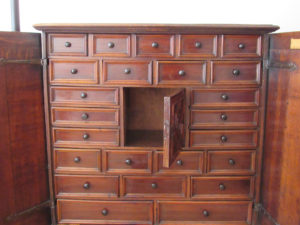 My history with Scotland includes meeting my son’s father there. So when DG sent me an old Scottish chest of drawers, the prospect of fruitful research thrilled me. DG grew up with that Captain’s Chest in Santa Barbara. But DG knows the undervalue of British “Brown” furniture. He said perhaps the love his family lavished on the chest for generations might not be equal to its monetary value.
My history with Scotland includes meeting my son’s father there. So when DG sent me an old Scottish chest of drawers, the prospect of fruitful research thrilled me. DG grew up with that Captain’s Chest in Santa Barbara. But DG knows the undervalue of British “Brown” furniture. He said perhaps the love his family lavished on the chest for generations might not be equal to its monetary value.
A label inside the chest states “Collection of Sir George Nobel of Newcastle: Scottish carved oak, Period Charles II, date 1655, applied carving stand of later date.”
First I explained the role of the piece to DG’s family. In the late 17th century, even the finest houses held few pieces of furniture. So, this piece, at almost 6’ tall, with a whopping 24-drawers, would’ve been a rare and treasured family possession costing a bundle. What did all those drawers contain?
In the Heart of a Scottish Chest
 We think of a chest of drawers as holding underwear, t-shirts, socks. But in the 17th century, a tall wood chest on a stand held important things in the family: documents, jewelry, silver, lace, small pieces of clothing, such as embroidered collars and cuffs. Each drawer became a treasure trove. Notice the many locks. A family who afforded such a piece employed servants, who liked to “borrow” those wonderful objects.
We think of a chest of drawers as holding underwear, t-shirts, socks. But in the 17th century, a tall wood chest on a stand held important things in the family: documents, jewelry, silver, lace, small pieces of clothing, such as embroidered collars and cuffs. Each drawer became a treasure trove. Notice the many locks. A family who afforded such a piece employed servants, who liked to “borrow” those wonderful objects.
Notice the drawers are of different “courses,” which means a series of same-sized drawers on one level of different sizes. This held gradations of what a family held dear. If you think about the name “chest,” this name has significance because the chest held the heart – the “belongings” of an upper-class family.
With so many objects in our homes today I find it difficult to imagine one chest held family treasures for generations. The scarcity of objects in the 17th century led people to put more ‘store’ in the storage of objects they held dear.
They used those drawers over generations so the pulls (handles) often needed replacing. DG wrote me, “To think the original pulls, bronze centuries ago, were replaced with wood, gives me chills…to imagine the number of people who used/touched/appreciated this piece over the years is amazing.” After learning the rarity of such a piece, still intact since the 17th century, DG’s children will argue over the inheritance of the Brown piece of furniture.
Security Systems of Such a Piece of Furniture
The drawers are fitted with escutcheons for locks and keys, plus over the entire front, two double doors enclose the drawers, also with a locking mechanism. Not just a simple lock, but a lock bolstered by hinges that spanned the width of the doors in flanges that served as brackets to join the boards of the doors together. The strong doors defended the drawers further.
Today we put a piece of furniture in one place and don’t move it. But in the 17th century they moved such furniture often around rooms. A piece might have a seasonal location, or they may have transported it to another home owned by the family. So they mounted pieces like DG’s on stands, often carved and set on “high legs,” which meant the weight of the case piece would be moved. In American and England, these pieces were called highboys. The function of such pieces mounted on high-legged stands was ease of moving. Remember the French word for furniture is moblier – movables. For example, if DG’s piece, in a certain season, held linens and bedclothes, they might move it for accessibility to a dining area to hold silver.
This piece has provenance.
I found the genealogy of the “Noble” family that owned the piece in the 17th century. Yet I didn’t find the image of the “Noble” estate in Scotland. I did, however, find an ancestor in the 19th century a great inventor. If he’d known his family’s chest made its way to San Diego and then sold and moved to Santa Barbara, he would have felt amazed.
Great pieces like this tell us a story. The value? Because some collectors still treasure this era of furniture, it’s in the five-figures. Although the market for what we call “Brown” (British 17th and 18th century) furniture, remains decidedly low today.